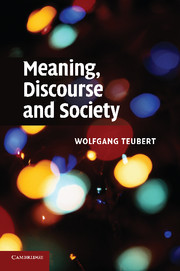Book contents
- Frontmatter
- Contents
- Acknowledgements
- Introduction
- Part I Meaning, the mind and the brain
- Part II Discourse and society
- 8 Language as discourse
- 9 Society presupposes language, and language presupposes society
- 10 A closer look at oral societies
- 11 Differences between oral and literate societies
- 12 Empirical linguistics deals only with recorded language
- 13 Meaning, knowledge and the construction of reality
- 14 The language of the scientific experimental report
- 15 Diachronicity, intertextuality and hermeneutics
- 16 Meaning and the interpretation of a haiku
- Conclusion
- Bibliography
- Index
14 - The language of the scientific experimental report
Published online by Cambridge University Press: 04 August 2010
- Frontmatter
- Contents
- Acknowledgements
- Introduction
- Part I Meaning, the mind and the brain
- Part II Discourse and society
- 8 Language as discourse
- 9 Society presupposes language, and language presupposes society
- 10 A closer look at oral societies
- 11 Differences between oral and literate societies
- 12 Empirical linguistics deals only with recorded language
- 13 Meaning, knowledge and the construction of reality
- 14 The language of the scientific experimental report
- 15 Diachronicity, intertextuality and hermeneutics
- 16 Meaning and the interpretation of a haiku
- Conclusion
- Bibliography
- Index
Summary
Both science and engineering are about new knowledge. While engineering is about inventing a new gadget or a new process, science is about discovering something that was already there but was not known about before. What is invented and what is discovered are part of the real world out there (or so it seems). Some doubts might not be amiss, however. New inventions are said to serve a purpose or to have a function. A plough is there to plough. But who decides what should be called ploughing and what not? A new pill is certainly real, but how real is the depression which it is supposed to cure? Artefacts and inventions presuppose a discourse. The discourse makes us aware that there is something we are missing. It gives us the idea that something could be done about it. Even before these artefacts and these inventions are around, we turn these objects of the world out there into discourse objects. We talk about our ideas, explain them in relationship to other discourse objects, and discuss what we like and do not like about them. As discourse objects, they become part of our knowledge. One of the reasons why even chimpanzees are pretty poor at engineering is that they cannot discuss their needs and the possible options to meet them.
Science is about facts. According to the Cobuild Dictionary (3rd edition 2001), facts are ‘pieces of information that can be discovered’.
- Type
- Chapter
- Information
- Meaning, Discourse and Society , pp. 190 - 198Publisher: Cambridge University PressPrint publication year: 2010

